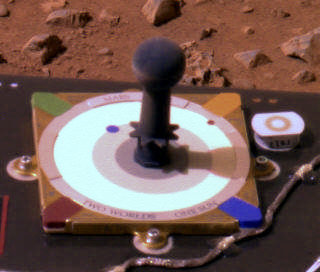Recently I sat in on an energetic workshop for preschoolers at Chabot Space and Science Center in Oakland, watching 15 "Tyke Explorers" assume ownership of the entire Solar System in a kid-sized multimedia extravaganza called "Dance of the Planets."
Tyke wrangler Ken Yamata awarded each unadorned Styrofoam plate -- small for the rocky inner planets, large for the gas giants -- to the youngster who seemed most enthusiastic about that particular Solar System object. The girl who'd thrust her hand high in the air when the red planet was offered up to the group claimed Mars.
"Why did you want to be Mars?" I asked her afterwards.
I thought she might say that Mars is closest to being like Earth. Or that it may be our next home. Or even that it is named for a powerful god. I was not prepared for her unabashed reply:
"I like pink. It was closest to pink."
And this was true. All the undecorated plates were stark-white except for one, which was rose-hued: Mars, the perfect planet for a young Martian princess.
Princess of Mars? (Credit: Transmedia SF)
Is going after the hue rather than the planet a manifestation of the "pink princess" culture surrounding girls from soon after birth, at least until they're able to choose their own wardrobes and dress themselves? Can we blame this "pinkification" entirely on Disney films and a shopping spree at Walt's company store, or is it more pervasive than that, persisting even as the girls mature into young women?
I read an article in which a female high-school senior with engineering ambitions complained about all the pink, pretty, curly, flowery announcements she'd received inviting her to be a "Web diva" (rather than "Web developer"). She called it "degrading."
Tech companies who use ingrained gender associations to attract qualified women to their ranks are not thinking beyond the limits of their own cultural associations. They are certainly not thinking of the young women they want to hire as anything more than an underrepresented category easily and superficially defined. The nobleness of the goal is sadly diminished by the means.
We must share the blame as a culture. Why do we consider the color pink so demeaning and limiting while we persist in allowing it to define our young women? Is this an indication of how little we value girls and their futures?
If the tech companies need to boost their female ranks, why can't we at the very least use their misappropriation of pinkness as a teaching moment, call them on their shallow and stereotypical representations and demand that they do differently? These days I hear a lot of complaining but not even a faint call to action.
Color is a tool, not only on Earth but beyond it, where scientists struggle to represent colors that defy precise definition with terms like "false color," "perceptive color," and "representative color." What's missing is "true color," because there is no absolute true color in our universe.
Just take a look at our "red" neighbor, Mars, in the night sky, glowing from reflected sunlight. It's more rosy than red, and certainly not crimson, scarlet or any of the more vibrant reds. The color is being filtered through our own atmosphere.
"MarDials" are color-calibration devices that allow scientists to adjust colors recorded by cameras on the surface of Mars, where hues are naturally filtered through the salmon-colored sky and a considerable amount of dust in the air, unlike the blue-sky view we have on Earth.
A photo from Mars' surface. Not red! (Credit: NASA)
MarsDial: Choose your Mars hue here! (Credit: NASA)
The "MarDials" on Spirit and Opportunity have this inscription: "Two worlds, one sun." The sunlight may be constant, but the intervening variables between the two worlds -- from atmosphere to digital processing to individual computer-monitor and printer settings -- add layers of insistent hue-shifting filters. Human perception is just another filter.
The color pink means nothing, certainly not "girly." Up until the mid-20th century, boys were routinely dressed in pink and girls in blue. A trade publication published these guidelines in 1918:
The generally accepted rule is pink for the boys, and blue for the girls. The reason is that pink, being a more decided and stronger color, is more suitable for the boy, while blue, which is more delicate and dainty, is prettier for the girl.
That's just further proof that we, as humans, are the ultimate arbitrators of colors -- and their meaning.
The girl who chose Mars because it's pink may indeed be the next Martian warrior princess, fully empowered by the color she embodies, because, as we all know, pink is just a lighter shade of red.


